-
Post-Mount Hopper Bird Feeder Offers Major Curb Appeal
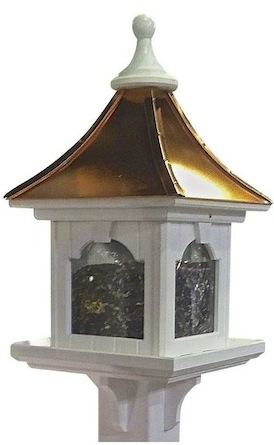 Larger seed feeders seem to be banished to the backyard, likely for the best viewing options. Sometimes on the side of a home, but you do occasionally see them in the front. Some folks may place a beautiful birdhouse in the landscape… simply for the aesthetic. But those who actually feed the birds are serious!
Larger seed feeders seem to be banished to the backyard, likely for the best viewing options. Sometimes on the side of a home, but you do occasionally see them in the front. Some folks may place a beautiful birdhouse in the landscape… simply for the aesthetic. But those who actually feed the birds are serious!Gazebo style feeders offer a traditional architectural accent, some with Victorian flair, others even more creative. But the tube, the tube’s the problem for the serious backyard birder. They’re relatively small, holding maybe one or two pounds of seed. With winter still hanging on and natural food sources depleted, birds have been ravenous around feeders. And with spring bulbs already forcing through the ground, migratory friends will soon arrive (whether the weather cooperates or not!)
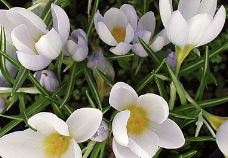
Enter the post-mount hopper bird feeder with ten-pound capacity and majestic appearance. A distinctive accent for the landscape, it’s definitely worthy of the front lawn. Because the roof is copper, and that’s actually vinyl/PVC (not wood) its appearance remains new. In fact it’s guaranteed against rotting, cracking or warping. Vinyl will not mildew, making it a healthier feeding surface for birds. Bacteria and mold have nowhere to settle, no deep, dark cracks or crevices in which to grow.
Hopper style feeders like these are one-time investments in the landscape with ideal functionality to entice feathered friends. They’re simple to fill, clean and are virtually maintenance-free. An aged patina finish is offered, as well as a hanging model. Lots of options with easy installation too – slides right on a standard 4×4 post, brackets included as shown.
Save 10% through 3/15. Use code MC10 and feed the birds in high style… now come on spring!
-
The Late Frenzy Around Thistle Feeders
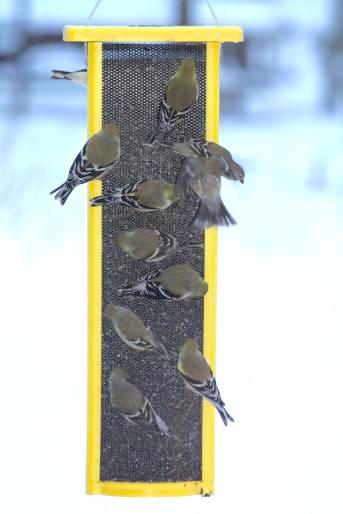 It’s an invasion of goldfinches… and pine siskins, and red polls and warblers and lots of other birds too lately! With the extreme cold weather, thistle feeders are being emptied at record rates, even Atlanta saw some of the white stuff, with more expected on Tuesday.
It’s an invasion of goldfinches… and pine siskins, and red polls and warblers and lots of other birds too lately! With the extreme cold weather, thistle feeders are being emptied at record rates, even Atlanta saw some of the white stuff, with more expected on Tuesday.Birds seem ravenous around all of the feeders, and rightly so – it’s freakin’ freezing out there! With blustery winds and 12 degree temps a few days ago, my hands were not only numb… they actually hurt upon finishing the A.M. feeding routine. Placing them over a hot burner on the stove, then under hot water, I felt fairly sure it was frostbite 🙁
So how do they do it? Fragile, tiny little birds surviving the most frigid conditions, day in and day out? I don’t know! Looking like puff balls, their feathers do trap heat for one survival tactic, and if they constantly eat all day, they’re able
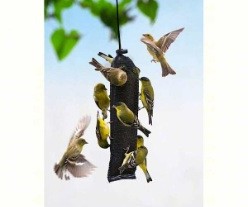 to store enough calories (energy) to hold them through the night. And yes, they can eat snow but it takes energy to convert it to liquid. Their daily struggle’s got to get old in these brutal winter conditions? Cardinals, bluebirds, woodpeckers, phoebes, a lone mockingbird, chipping sparrows and all the other usual suspects abound… and yet with snow on the ground!
to store enough calories (energy) to hold them through the night. And yes, they can eat snow but it takes energy to convert it to liquid. Their daily struggle’s got to get old in these brutal winter conditions? Cardinals, bluebirds, woodpeckers, phoebes, a lone mockingbird, chipping sparrows and all the other usual suspects abound… and yet with snow on the ground!But it’s really just instinct when you think about it. Mother Nature equips all beings with this basic survival mode. She also equips some of us with the lunacy that the birds won’t make it unless you put food out twice a day… and have 3 heated birdbaths readily available 🙂 But we do it not only for the birds, but for our own satisfaction of feeling like we helped, and the simple joy derived from watching them.
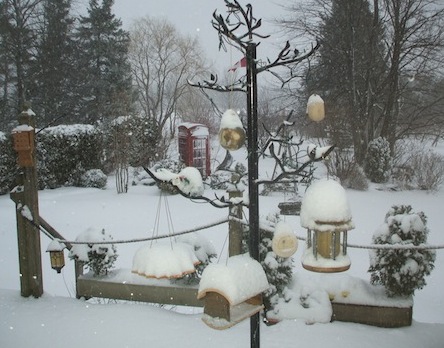 Should you reside anywhere old man winter’s got a death grip… please look out for feathered friends!
Should you reside anywhere old man winter’s got a death grip… please look out for feathered friends!Keep feeders filled (and clean). Larger than normal bird populations crowding feeders is one way disease is spread.
Offer fresh water, birds will flock to a heated bath. You can purchase a heater separately and add it to your existing bath or even a shallow pan of water.
Put out extra suet, easily make your own, form into cakes for suet cages, or crumbles for platform or dish feeders. High fat foods that are easy to digest serve birds well in freezing weather.
Peanuts are ideal, as is plain old peanut butter. We smear some right on a tree trunk! Nuthatches, woodpeckers and warblers love it.
Add an extra thistle sock for the crowds of finches. Relatively inexpensive, the black mesh thistle feeders are stronger and generally more durable than most.
Stay safe and warm… and please feed the birds 🙂
Visit our site and save 10% on any birding items through 2/28.
Use promo code MC10.
Free shipping on $95 -
Whole or Shelled Nuts for Peanut Bird Feeders?
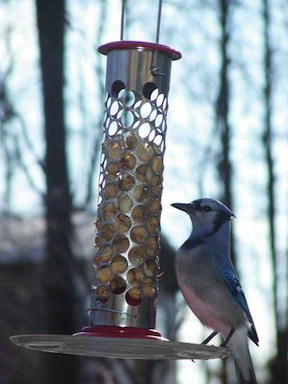 Depends on who you’re looking to attract? Most clinging birds covet shelled peanuts, in fact almost all birds will go for them. But not all birds are clingers, classified by their ability to grasp a small surface (and their strong feet). Chickadees, nuthatches, woodpeckers and titmice for the most part are considered clingers. The term not to be confused with clingons from Star-Trek 🙂
Depends on who you’re looking to attract? Most clinging birds covet shelled peanuts, in fact almost all birds will go for them. But not all birds are clingers, classified by their ability to grasp a small surface (and their strong feet). Chickadees, nuthatches, woodpeckers and titmice for the most part are considered clingers. The term not to be confused with clingons from Star-Trek 🙂Adding a tray to peanut bird feeders allows other birds to easily get the goods. Jays adore peanuts, warblers go for them in winter, as will most backyard birds during frigid weather. The tray is inviting, making landing and eating easier.
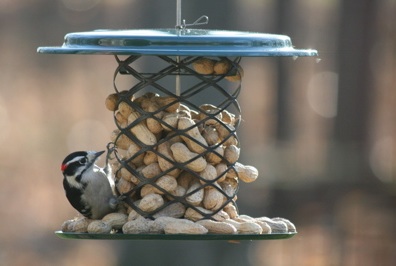
Larger trays even catch waste from whole peanuts, which folks who could do without the waste might find more appealing. Although when feeding shelled peanuts… there’s really not much waste all. So that alone may influence what’s best to offer at your place! Many shelled peanut feeders offer tray options-but should they not- a universal seed catcher is available to accommodate them.
If the waste from feeding birds is a big drawback, large adjustable seed
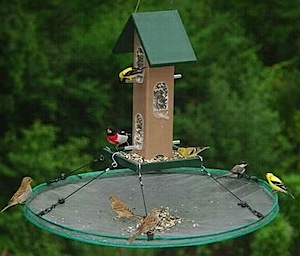 trays could be the answer. Attaching to almost any type of feeder, the large 16- or 30-inch diameter promises to catch anything that falls from the feeder. These also create a new feeding space with their large platform area. Peanuts pack a real punch in terms of nutritional value, especially in cold weather. They’re economical if purchased in bulk too. So don’t give up the ship due to the mess some peanut bird feeders may leave behind!
trays could be the answer. Attaching to almost any type of feeder, the large 16- or 30-inch diameter promises to catch anything that falls from the feeder. These also create a new feeding space with their large platform area. Peanuts pack a real punch in terms of nutritional value, especially in cold weather. They’re economical if purchased in bulk too. So don’t give up the ship due to the mess some peanut bird feeders may leave behind!
